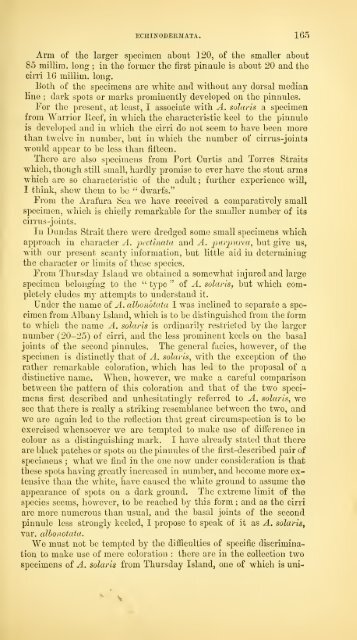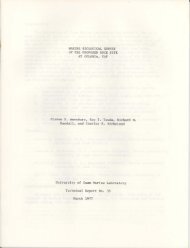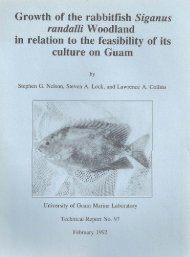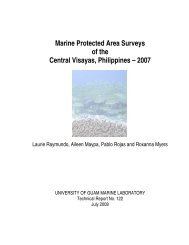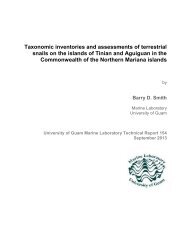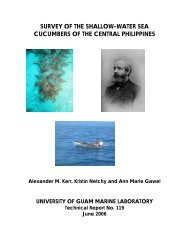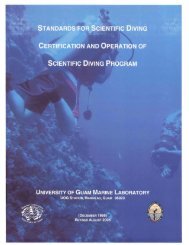Create successful ePaper yourself
Turn your PDF publications into a flip-book with our unique Google optimized e-Paper software.
ECniNODERMATA. 165<br />
Arm of the larger specimen about 120, of the smaller about<br />
85 millim. long ; in the former the first pinnule is about 20 and the<br />
cirri 10 millim. long.<br />
Both of the specimens are white and without any dorsal median<br />
line ; dark spots or marks prominently developed on the pinnules.<br />
For the present, at least, I associate with A. solans a specimen<br />
from Warrior Reef, in which the characteristic keel to the pinnule<br />
is developed and iu which the cirri do not seem to have been moro<br />
than twelve in number, but in which the number of cirrus-joints<br />
would appear to be less than fifteen.<br />
There are also specimens from Port Curtis and Torres Straits<br />
which, though still small, hardly promise to ever have the stout arms<br />
which are so characteristic of the adult ; further experience will,<br />
I think, show them to be " dwarfs."<br />
Prom the Arafura Sea we have received a comparatively small<br />
specimen, which is chiefly remarkable for the smaller number of its<br />
cirrus-joints.<br />
In Dundas Strait there were dredged some small specimens which<br />
approach iu character A. pectinata and A. purpurea, but give us,<br />
with our present scanty information, but little aid in determining<br />
the character or limits of these species.<br />
From Thursday Island we obtained a somewhat injured and large<br />
specimen belonging to the " type " of A. Solaris, but which com-<br />
pletely eludes my attempts to understand it.<br />
Under the name of A. alhonbtuta I was inclined to separate a specimen<br />
from Albany Island, which is to be distinguished from the form<br />
to which the name A. Solaris is ordinarily restricted by the larger<br />
number (20-25) of cirri, and the less prominent keels on the basal<br />
joints of the second pinnules. The general facies, however, of the<br />
specimen is distinctly that of A. Solaris, with the exception of the<br />
rather remarkable coloration, which has led to the proposal of a<br />
distinctive name. When, however, we make a careful comparison<br />
between the pattern of this coloration and that of the two specimens<br />
first described and unhesitatingly referred to A. Solaris, we<br />
see that there is really a striking resemblance between the two, and<br />
we are again led to the reflection that great circumspection is to be<br />
exercised whensoever we are tempted to make use of difference in<br />
colour as a distinguishing mark. I have already stated that there<br />
are black patches or spots on the pinnules of the first-described pair of<br />
specitueus ; what we find in the one now under consideration is that<br />
these spots having greatly increased in number, and become more extensive<br />
than the white, have caused the white ground to assume the<br />
appearance of spots on a dark ground. The extreme limit of the<br />
species seems, however, to be reached by this form ; and as the cirri<br />
are more numerous than usual, and the basal joints of the second<br />
pinnule less strongly keeled, I propose to speak of it as A. Solaris^<br />
var. alhonotata.<br />
We must not be tempted by the diflSculties of specific discrimination<br />
to make use of mere coloration :<br />
there are in the collection two<br />
specimens of A. Solaris from Thursday Island, one of which is uni-


